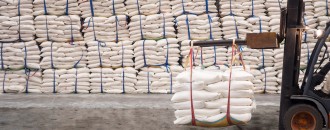
Union Budget 2016: Pulse(s) of the matter
 The Union Budget 2016 announced on Monday had a renewed focus on the agricultural sector with increased funding to pulse production, crop insurance, irrigation schemes and e-market for farm produce.
Among the major budget announcements giving major push for agriculture was allocation of Rs 500 crore for enhancement of pulse production to cover 622 districts under the National Food Security Mission.
Union Finance Minister Arun Jaitley also made the announcement of the government approving creation of buffer stock of pulses through procurement at Minimum Support Price (MSP) and at market price through Price Stabilisation Fund. “This Fund has been provided with a corpus of Rs.900 crore to support market interventions,” he said. The announcement was among a number of measures taken to deal with the problem of abrupt increase in prices of pulses.
The budget announcements laying thrust on the farming sector couldn’t have come at a more appropriate time as agriculture in India is going through a period of distress following two back-to-back drought years. The announcements that comes well ahead of the monsoon period and before the commencement of kharif plantings is likely to send the right signals to farmers.
The prices of pulses, the main source of protein have been spiraling for quite some time now on account of falling domestic output. With the prices of pulses shooting up, the government had recently taken firefighting measures to check the prices. Among them was the imports of pulses, imposing restrictions on holding of pulses stock beyond a ceiling and invoking a Rs.500 crore Price Stabilisation Fund to pay for transportation, handling and processing of imported pulses.
It is worthy to be mentioned that India holds a distinction of being the world’s biggest producer and consumer of pulses. However, the domestic production of pulses is not sufficient to meet the demand consistently. To fill in the demand-supply gap, we import large quantities every year.
Interestingly, the Associated Chamber of Commerce and Industry (ASSOCHAM) in its study recently claimed that India might need to import more than 10 MMT of pulses to meet the domestic consumption demand during the current financial year as the production was expected to go down due to shortage of rain.
Going by the statistical data by Directorate of Economics and Statistics (DES), Department of Agriculture & Cooperation (DAC) and Department of Commerce (DoC), India’s estimated pulse production during 2015-16 stood at 18.32 million metric tonne (MMT) as against 17.38 MMT in 2014-15.
The Union Budget 2016 announced on Monday had a renewed focus on the agricultural sector with increased funding to pulse production, crop insurance, irrigation schemes and e-market for farm produce.
Among the major budget announcements giving major push for agriculture was allocation of Rs 500 crore for enhancement of pulse production to cover 622 districts under the National Food Security Mission.
Union Finance Minister Arun Jaitley also made the announcement of the government approving creation of buffer stock of pulses through procurement at Minimum Support Price (MSP) and at market price through Price Stabilisation Fund. “This Fund has been provided with a corpus of Rs.900 crore to support market interventions,” he said. The announcement was among a number of measures taken to deal with the problem of abrupt increase in prices of pulses.
The budget announcements laying thrust on the farming sector couldn’t have come at a more appropriate time as agriculture in India is going through a period of distress following two back-to-back drought years. The announcements that comes well ahead of the monsoon period and before the commencement of kharif plantings is likely to send the right signals to farmers.
The prices of pulses, the main source of protein have been spiraling for quite some time now on account of falling domestic output. With the prices of pulses shooting up, the government had recently taken firefighting measures to check the prices. Among them was the imports of pulses, imposing restrictions on holding of pulses stock beyond a ceiling and invoking a Rs.500 crore Price Stabilisation Fund to pay for transportation, handling and processing of imported pulses.
It is worthy to be mentioned that India holds a distinction of being the world’s biggest producer and consumer of pulses. However, the domestic production of pulses is not sufficient to meet the demand consistently. To fill in the demand-supply gap, we import large quantities every year.
Interestingly, the Associated Chamber of Commerce and Industry (ASSOCHAM) in its study recently claimed that India might need to import more than 10 MMT of pulses to meet the domestic consumption demand during the current financial year as the production was expected to go down due to shortage of rain.
Going by the statistical data by Directorate of Economics and Statistics (DES), Department of Agriculture & Cooperation (DAC) and Department of Commerce (DoC), India’s estimated pulse production during 2015-16 stood at 18.32 million metric tonne (MMT) as against 17.38 MMT in 2014-15.
February 29, 2016 | 06:05pm IST






 to success.
to success.